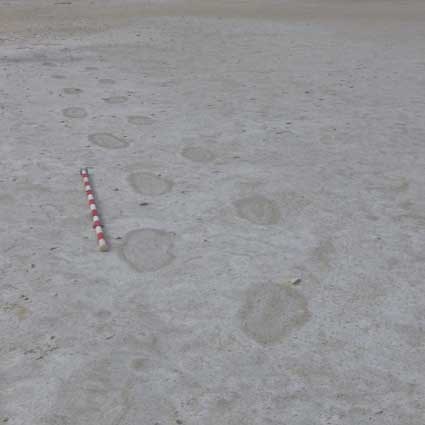Last updated: May 8, 2018
Article
How Scientists Study the White Sands National Monument Fossil Tracks

NPS photo
Clues from ancient plants and animals litter the shimmering white sands of New Mexico. For decades scientists and curious residents have found and recorded fossils in this area. Their studies add greatly to our knowledge of the animals that lived in this area millions of years ago.
Timeline of discovery
Local resident George Ellis Wright first reported fossil tracks in 1931. Wright discovered the tracks in the Tularosa basin, part of White Sands National Monument. He saw large, elongated, side-by-side tracks, evidence that a bipedal animal (one that walks on two legs) created them. Wright figured a giant human had made these prints.
Fast forward 50 years. In 1981, Peter Eidenbach of New Mexico State University started research on other fossil footprints found along the northern shoreline of ancient Lake Otero. Eidenbach concluded Pleistocene* mammals, such as mammoths and camels, likely made the fossil tracks.
Interest sparked again in the early 2000s. Spencer Lucas of the New Mexico Museum of Natural History continued the research near Lake Otero. Lucas and his team confirmed Late Pleistocene tracks in areas outside of White Sands National Monument. But in 2011, staff and volunteers at White Sands began to record fossilized footprints inside the monument’s borders. At first, they found dozens of tracks, then hundreds, and finally thousands of fossil footprints. By 2014, researchers called the large number of fossil footprints in the monument a "Late Pleistocene megatracksite."
Research techniques
White Sands is home to a large number and variety of fossil tracks, which raises a range of research questions. A team of several scientists, including geologists, paleontologists, archaeologists, etc., and managers worked together on various research questions about the fossil tracks. We wanted to learn more about the environment during the Late Pleistocene and the composition of the sediment, among other things.
It's difficult to collect specimens of these fossil footprints. They’re preserved in playa lake deposits and shorelines, made up of gypsum-rich sediments. Gypsum tends to be soft and chalky. These characteristics make the fossil tracks at White Sands delicate and short-lived: they break down quickly once exposed at the surface.
To protect the fossil tracks, the NPS developed a non-invasive strategy to inventory and monitor the fragile fossils using a technique known as photogrammetry. It's a photographic technique that takes detailed measurements and creates 3D models of objects, in this case fossil tracks. In 2014, researchers began using an unmanned aerial vehicle (UAV) equipped with cameras to collect the photos and videos needed to create the 3D models of the fossil tracks at the monument.

NPS Photo
Whose tracks?
Thanks to this research, scientists now have a better idea of which animals made the tracks. They have evidence that extinct Late Pleistocene mammals made all of the tracks, and large proboscideans, such as mammoths, likely left the most common fossil tracks and trackways in the monument. Perhaps the most exciting discovery at the monument is the ground sloth footprints—this is only the second time scientists identified ground sloth tracks in North America! Some other fossil tracks are likely from large and small carnivores, such as dire wolves and saber-toothed cats. Scientists also identified footprints made by the large, extinct Ice Age camel. Future fieldwork and research may lead to the discovery of tracks left by other Late Pleistocene fauna.
REFERENCES
Lucas, S. G., Allen, B. D., Morgan, G. S., Myers, R. G., Love, D. W., and Bustos, D., 2007, Mammoth Footprints from the Upper Pleistocene of the Tularosa Basin, Dona Ana County, New Mexico: New Mexico Museum of Natural History & Science Bulletin 42, pp. 149-154.
Lucas, S. G., Morgan, G. S., Hawley, J. W., Love, D. W., and Myers, R.G., 2002, Mammal Footprints from the upper Pleistocene of the Tularosa Basin, Dona Ana County, New Mexico: New Mexico Geological Society Guidebook 53, pp. 285-288.
Santucci, V.L., J.S. Tweet, D. Bustos, J. Von Haden, and P. Varela. 2014. Vertebrate Paleontological Resources from National Park Service Areas in New Mexico. New Mexico Museum of Natural History Bulletin 64: 1-9.
